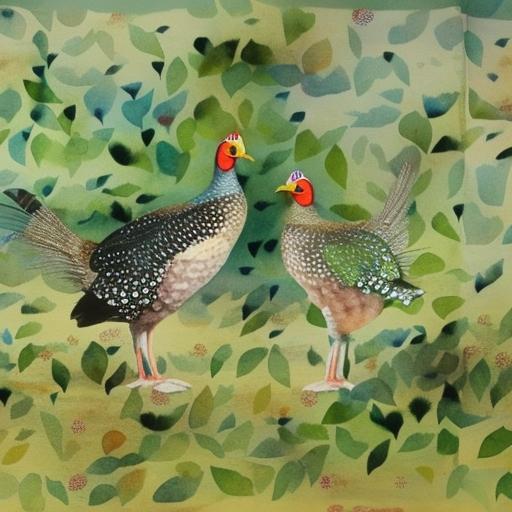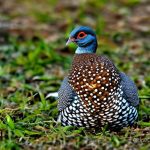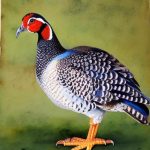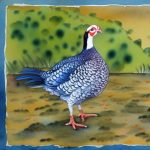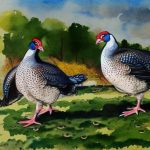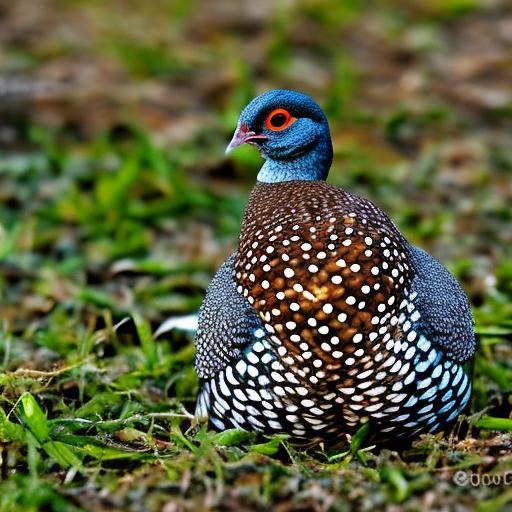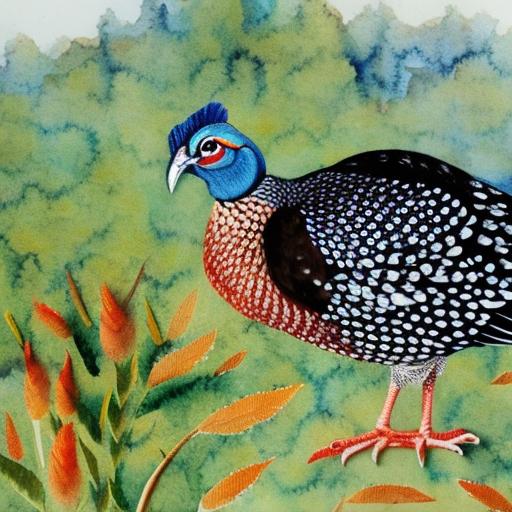Guinea fowl, also known as pintades, are a type of game bird native to Africa. They are popular for their unique appearance, with their speckled feathers and distinctive helmet-like casque on their heads. Guinea fowl are not only valued for their ornamental qualities but also for their practical uses, such as pest control and meat production. They are hardy birds that can adapt to various climates and are relatively low-maintenance, making them an attractive option for poultry enthusiasts.
Guinea fowl are social birds that thrive in small flocks, and they are known for their loud calls and alert nature, which makes them excellent watchdogs for the farm. They are also known for their insect-eating habits, making them valuable for pest control in gardens and agricultural settings. In addition to their pest control abilities, guinea fowl are also raised for their flavorful and lean meat, which is considered a delicacy in many parts of the world. With their unique characteristics and practical uses, guinea fowl are a fascinating and rewarding bird to breed and raise.
Key Takeaways
- Guinea fowl are unique birds known for their insect-eating abilities and distinctive calls.
- Breeding season for guinea fowl typically occurs in the spring and early summer months.
- Signs of breeding readiness in guinea fowl include increased vocalization, mating behavior, and the formation of breeding pairs.
- Guinea fowl exhibit nesting and egg-laying behavior in secluded areas, often creating shallow depressions in the ground for their eggs.
- The incubation and hatching process for guinea fowl eggs takes approximately 26-28 days.
- Caring for guinea fowl chicks involves providing warmth, protection, and a balanced diet to ensure their healthy development.
- In conclusion, breeding guinea fowl requires careful observation of breeding readiness signs and proper care for the eggs and chicks.
Understanding the Breeding Season
Guinea fowl are seasonal breeders, with the breeding season typically occurring in the spring and early summer months. The length of the breeding season can vary depending on the climate and environmental conditions, but it generally lasts from March to August. During this time, guinea fowl become more active and vocal, displaying courtship behaviors such as strutting, calling, and wing-fluttering. Male guinea fowl, known as cocks, will often engage in elaborate displays to attract the attention of females, known as hens.
The breeding season is triggered by increasing daylight hours, which stimulates hormonal changes in guinea fowl that lead to mating behavior. As the days grow longer and temperatures rise, guinea fowl become more inclined to breed. It is important for breeders to be aware of the natural breeding season of guinea fowl in order to optimize breeding success. By understanding the timing and triggers of the breeding season, breeders can provide the appropriate conditions and care to encourage successful mating and egg production.
Signs of Breeding Readiness in Guinea Fowl
There are several signs that indicate when guinea fowl are ready to breed. One of the most obvious signs is the increased vocalization and activity levels displayed by both male and female guinea fowl during the breeding season. Cocks will often strut and display their plumage while emitting loud calls to attract the attention of hens. Hens, on the other hand, may become more receptive to the advances of males and will display submissive behaviors such as crouching and vocalizing in response to courtship displays.
Another sign of breeding readiness in guinea fowl is the formation of mating pairs within the flock. During the breeding season, males will establish dominance hierarchies and form pair bonds with specific females. These pairs will often engage in preening each other and engaging in mutual courtship behaviors. Additionally, females may exhibit changes in behavior such as seeking out suitable nesting sites and displaying nesting behaviors such as scratching at the ground or exploring potential nest locations. By observing these signs of breeding readiness, breeders can identify when their guinea fowl are prepared to mate and lay eggs.
Nesting and Egg-laying Behavior
Once guinea fowl have formed mating pairs and are ready to breed, hens will begin to seek out suitable nesting sites to lay their eggs. Guinea fowl are ground-nesting birds, meaning they prefer to lay their eggs in secluded spots on the ground rather than in elevated nests. Hens will often scratch at the ground to create a shallow depression or seek out natural hiding spots such as dense vegetation or brush piles to build their nests. It is important for breeders to provide suitable nesting materials such as straw or hay to encourage hens to build their nests in designated areas.
Guinea fowl hens are prolific layers, typically laying one egg per day until they have completed a clutch of eggs, which can range from 12 to 20 eggs depending on the individual hen. Once a hen has completed her clutch, she will begin incubating her eggs by sitting on them for approximately 26-28 days until they hatch. During this time, hens will diligently tend to their nests, turning the eggs regularly and keeping them warm and protected from predators. Breeders should provide nesting boxes or secluded areas with suitable nesting materials to ensure that hens have a safe and comfortable environment for laying and incubating their eggs.
Incubation and Hatching Process
After a hen has completed her clutch of eggs and begun incubating them, breeders should monitor the incubation process closely to ensure successful hatching. Guinea fowl eggs require consistent warmth and humidity for proper development, so it is important to provide suitable incubation conditions. If a hen is incubating her eggs naturally, it is crucial to provide her with a quiet and secure environment free from disturbances to minimize stress and maximize hatching success.
Once the incubation period is complete, guinea fowl chicks will begin to hatch from their eggs. Chicks are precocial, meaning they are born with their eyes open and are capable of walking and feeding themselves shortly after hatching. Breeders should provide a warm and safe brooding area for newly hatched chicks, equipped with heat lamps or brooding plates to maintain optimal temperature levels. It is important to closely monitor chicks during this critical period to ensure they are healthy and thriving.
Caring for Guinea Fowl Chicks

Caring for guinea fowl chicks requires attention to their specific needs during the early stages of development. Chicks should be provided with a balanced diet of high-quality chick starter feed supplemented with vitamins and electrolytes to support their growth and immune system development. Additionally, chicks should have access to clean water at all times to prevent dehydration.
As chicks grow, they will require access to outdoor areas where they can forage for insects and other natural foods. Providing a safe and secure outdoor enclosure will allow chicks to develop their natural foraging instincts while remaining protected from predators. It is important for breeders to closely monitor the health and behavior of guinea fowl chicks as they grow, providing appropriate care and addressing any potential health issues promptly.
Conclusion and Tips for Breeding Guinea Fowl
Breeding guinea fowl can be a rewarding experience for poultry enthusiasts, offering both practical benefits such as pest control and meat production as well as the enjoyment of raising these unique and fascinating birds. By understanding the natural breeding season of guinea fowl and recognizing signs of breeding readiness, breeders can optimize breeding success and ensure healthy offspring. Providing suitable nesting areas and monitoring the incubation process are essential for successful hatching, while attentive care is crucial for raising healthy guinea fowl chicks.
In conclusion, breeding guinea fowl requires knowledge of their natural behaviors and specific care requirements during the breeding season and beyond. By providing appropriate conditions and attentive care, breeders can enjoy the benefits of raising guinea fowl while contributing to the conservation of these remarkable birds. With proper understanding and dedication, breeding guinea fowl can be a fulfilling endeavor for poultry enthusiasts of all levels.
If you’re considering breeding guinea fowl, it’s important to understand their mating season and breeding habits. Understanding the mating season for guinea fowl can help you plan and prepare for successful breeding. For more information on the mating season of poultry, including turkeys, check out this informative article on mating season for turkeys. Learning about the breeding behaviors of different poultry species can provide valuable insights for poultry enthusiasts and breeders.
FAQs
What is the breeding season of guinea fowl?
The breeding season for guinea fowl typically occurs during the spring and summer months, with peak breeding activity occurring from April to June.
At what age do guinea fowl start breeding?
Guinea fowl typically reach sexual maturity and start breeding at around 6 to 8 months of age.
How do guinea fowl choose a mate?
Guinea fowl typically form monogamous pairs, with males displaying their plumage and vocalizing to attract a mate. Once a pair is formed, they will often remain together for the breeding season.
How many eggs do guinea fowl lay during the breeding season?
During the breeding season, female guinea fowl can lay anywhere from 30 to 40 eggs, with each egg being laid approximately every other day.
How long does it take for guinea fowl eggs to hatch?
Guinea fowl eggs typically have an incubation period of around 26 to 28 days before hatching.
Do guinea fowl build nests for their eggs?
Female guinea fowl will often create shallow scrapes in the ground to serve as nests for their eggs, but they do not build elaborate nests like some other bird species.
Meet Walter, the feathered-friend fanatic of Florida! Nestled in the sunshine state, Walter struts through life with his feathered companions, clucking his way to happiness. With a coop that’s fancier than a five-star hotel, he’s the Don Juan of the chicken world. When he’s not teaching his hens to do the cha-cha, you’ll find him in a heated debate with his prized rooster, Sir Clucks-a-Lot. Walter’s poultry passion is no yolk; he’s the sunny-side-up guy you never knew you needed in your flock of friends!

